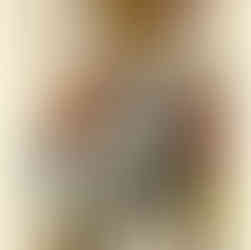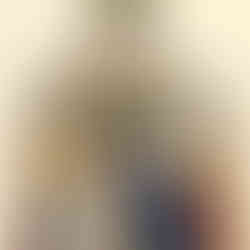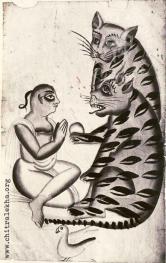Kalighat Cats
- Andrew Kelly

- Nov 8, 2020
- 3 min read
Updated: Nov 8, 2020
Unless otheriwise noted, all image below are from the Victoria and Albert Museum.

The cat is an emblem of hypocrisy: despite all its claims of being a celibate vegetarian here it has been caught red-toothed with a fish (an understandably unhappy looking fish) in its mouth. You can’t trust those sweet blue eyes!
In some versions, just to make things clear, the cat has sectarian, usually Vaishnavite (vaiṣṇava, of the god Viṣṇu), markings on its forehead:

This cat has many friends. A sample:

This trope goes back to a cat fable in the Mahābhārata epic (5.161) about a pious cat-guru whose mouse-disciples mysteriously go missing when they are alone with him: claiming he is weak from his austerities, he has them carry him to the river each evening, but none of them are ever seen again. Finally the mice convene a public meeting to discuss the issue...
As mentioned at the end of the Cats of Yoga note from last August, this cat guru appears in the 8th century Great Relief at Mammallapuram (Sanskrit: Mahābalipuram), with a close-up of the cat here. Its arms, just like that of the gaunt but vigorous human performing tree-pose above it, are held up in the ūrdhva-bāhu (‘raised arms’) austerity.
The cat is a warning to be skeptical about the claims (and requests for food) made by holy men. This is also built into the notion of the sad-guru/the true guru (sad is pronounced like bath suds). sat/sad is literally being, that which is, seen also in satyam/truth, reality. That is, gurus are either true or false.
This kind of traditional warning is very different from the calls emerging in the modern period that the guru system, with its leanings toward charismatic authoritarianism, should be abandoned (and then the countercalls that it should not). (Two separate but related roles are involved here: the ‘non-productive’ holy man or monk who is fed by the working community, and the guru whose house one enters for training.)
More on this in the note on the word guru.

Housewife whacking lascivious holy man with a broom, uncoloured outline of a Kālīghāṭ image: from a site dedicated to the Indian artist Mukul Dey (1895-1989).
_________________
The cat painting is in the19th century Kālīghāṭ style (literally ‘Kali’s landing’), named after the temple in Kolkata where they were sold as cheap souvenirs, covering first religious themes but branching out into satire and social commentary (directed in particular at the newly emerging Anglo-Indian elite). These were rapidly produced (and reproduced) in great numbers on low quality paper (using cheap British paper and cheap British paints). Outlining and colouring were separate stages with the first originally done by hand, but later also printed. The style is marked by an explosive sense of form and colour.
It stands in opposition to the Company School art — realist work produced by formerly Mughal artists to suit British tastes (where the palette is often bleak and the style realist) and British desires for graphic documentation of the peoples, animals and plants of the regions coming progressively under their control. But just as much as Company Art, Kālīghāṭ painting was new: starting around 1830, it had its highwater mark in the 1860s and faded out (with some modern revivers) by the 1930s.
It arose in the disrupted world of colonial Bengal where massive amounts of money had been shifted into new channels. As part of that, old systems of patronage had collapsed. Those changes were also expressed in geography: suddenly all roads lead to Kolkata, formerly a place of no great significance.
While Mughal court painters went to work in more or less the same mode for the British conquerers, village painters who had formerly produced narrative scrolls that would be rolled out as part of touring
In relation to the West and the modernity it created—in no small part through colonialism—the situation with Kālīghāṭ painting resembles that of ukiyo-e (‘floating world painting’) in Japan: humble, ephemeral work in their own setting, but collected by Westerners and ultimately transferred in great numbers into Western collections, first private and then increasingly public. The Victorian and Albert Museum has, it says, the largest collection in the world: 738 items appear in the catalogue, with this essay. Two albums of 100 paintings are in the Bodleian Library at Oxford, collected in 1884 by Sir Monier Monier-Williams (compiler of the 1899 Sanskrit-English dictionary). And so on, around the world. The NGV has a small, not so appealing set.
An account here of the evolution of Kālīghāṭ painting, with a discussion of the perhaps fruitless question 'Indian' or 'Western.'







































Comments